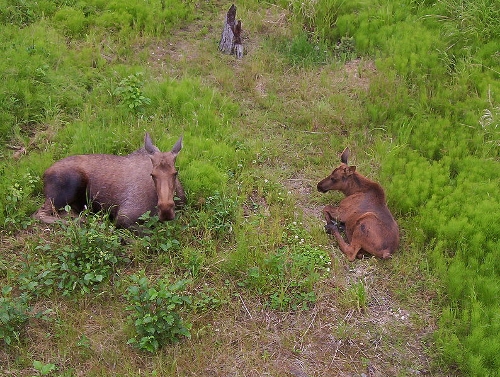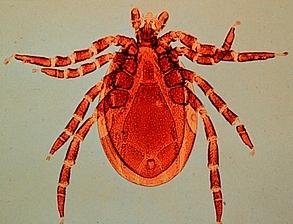Current Threats to Moose
Black Bears
Black bears are one of the major predators of moose, but only pose a threat to vulnerable moose calves and may occasionally attempt to take down an adult moose (“Black Bear” 4). A moose calf may become separated from its mother and bears often take this opportunity to prey on the helpless calf. Although it is not a risk to all moose, this predation is significant as moose have slow reproductive rates, meaning unlike to animals that bore thousands of young, this has a sizeable impact on moose populations. It is estimated that black bears are responsible for killing 42% of moose calves in some areas of the United States (“Black Bear” 2).
_______________________________________________________________________________________________________
 Brainworm
Brainworm
The brain worm, or parelaphostrongylus tenuis, is one of the moose’s deadliest pests. The white- tailed deer typically carries the brain worm but deer are immune to the brain worm’s effects("Brain Worm" 1). Moose are typically infected by accidentally ingesting the worm when foraging for tall vegetation or by ingesting small secondary hosts such as snails and slugs ("Brain Worm 2"). After the moose ingests the worm it travels to the spinal cord or brain of the moose and begins to inflict severe structural damage to the nervous system. This leads to swelling and ultimately paralysis, so that the moose cannot forage for vegetation, seek shelter,or escape predators it will ultimately die. (“Brain Worm” 1). Moose also pose threats to the human population when infected as the worm affects its judgement potentially leading to rabid behavior. There was an incidence of an infected moose laying in a cow field in the town of Steuben, NY in 2010 (Editorial Staff 2).
This threat to moose is amplified by the growth of the white tail deer population. Forty years ago the population of the white tailed deer in the Adirondack Park was estimated to be 30,000, whereas today it is estimated to be as high as 80,000 deer. The brainworm now has more agents to aid in its spread. In fact of 18 moose deaths examined in 2011, six were infected with the brainworm. This is only expected to increase with warming temperatures more attuned to brain worm preferences in coming decades (Editorial Staff 1).
_______________________________________________________________________________________________________
 Climate Change and Tick Density
Climate Change and Tick Density
In addition to the brain worm and black bear predation, gradually increasing temperatures in Northern latitudes has been putting a strain on the moose population. Moose thrive in a specific temperature window and are greatly impacted by the heat (“Moose” 3). Furthermore, increasing temperature also has a direct impact on moose as they correspond with increasing tick populations. A warmer shorter winter, due to climate change, has resulted in increasing tick populations in northern latitudes that have never dealt with the parasite in large numbers in the past (“Moose” 3). Ticks are starting to emerge in the Adirondack park for the first time and there is great concern on the impact this may have on moose ( Fears 2) . Moose typically pick up ticks while foraging for vegetation. Unfortunately, moose are unable to feel ticks when they latch on and thus thousands are able to bite a single moose without it realizing.Using the moose’s ignorance to their advantage thousands of ticks often team up on a single moose, bleeding it, causing anemia and ultimately death. In some cases the infestation of ticks leads to dramatic hair loss. These moose are often referred to as ghost moose for their pale skin due to blood and hair loss. Although not a main issue in the Adirondacks yet, this is already happening on Isle Royale in Michigan and many fear with the introduction of ticks into the Adirondacks, moose will face the same issues especially with the increase of lyme disease cases in Oneida county in 2013. (Fears 1).
For more information on Isle Royale Moose: http://www.isleroyalewolf.org/node/44
_______________________________________________________________________________________________________

Sources Cited
"A Moose Ruminating". Wikipedia Commons. N.p., 22 July 2009. Web. 9 May 2015.
"Black Bear." New York State Department of Environmental Conservation, n.d. Web. 25 Feb. 2015.
"Brain Worm." New York State, n.d. Web. 24 Feb. 2015.
"Brain Worm." Moose. NYS Department of Environmental Science, n.d. Web. 06 Apr. 2015.
"Breakfast Guests". Flickr. Yahoo, 16 Apr. 2010. Web. 10 May 2015.
"Deer Tick". Wikipedia Commons. N.p., 15 Oct. 2007. Web. 12 May 2015.
Editorial Staff. "Brain Worm Confirmed in New York Moose -." The Adirondack Almanack. Adirondack Explorer, 14 Feb. 2011. Web. 10 May 2015.
Fears, Daryl. "With Warmer Winters, Ticks Devastating N.H. Moose Population." Washington Post. 30 Apr. 2012. Web. 06 Apr. 2015.
